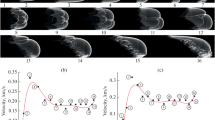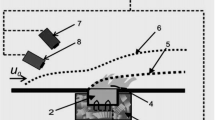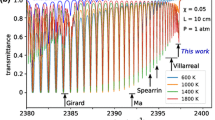Abstract
The chemical structure of an RDX flame at a pressure of 1 atm was studied using probing molecular beam mass spectrometry. The flame was found to contain RDX vapor, and its concentration profile was measured in a narrow zone adjacent to the burning surface. In addition to RDX vapor, ten more species were identified (H2, H2O, HCN, N2, CO, CH2O, NO, N2O, CO2 and NO2), and their concentration profiles were measured. Two main chemical-reaction zones were found in the RDX flame. In the first, narrow, zone 0.15 mm wide adjacent to the burning surface, decomposition of RDX vapor and the reaction of NO2, N2O, and CH2O with the formation of HCN and NO occur. In the second, wide, zone 0.85 mm wide, HCN is oxidized by NO to form the final combustion products. The composition of the final combustion products was analyzed from an energetic point of view. The measured composition of the products near the burning surface was used to determine the global reaction of RDX gasification at a pressure of 1 atm. Values of heat release in the condensed-phase calculated by the global gasification reaction and by the equation of heat balance on the burning surface (using data of microthermocouple measurements) were analyzed and compared.
Similar content being viewed by others
References
O. P. Korobeinichev, L. V. Kuibida, V. N. Orlov, A. G. Tereshchenko, K. P. Kutsenogii, R. V. Mavliev, N. E. Ermolin., F. M. Fomin, and I. D. Emel’yanov, “Mass-spectrometric probing investigation of flame structure and chemical reaction kinetics in flames,” in: V. L. Tal’roze, Mass Spectrometry and Chemical Kinetics [in Russian], Nauka, Moscow (1985), pp. 73–93.
L. V. Kuibida, “Investigation of flame structure nitramines using probing molecular beam mass spectrometry,” Doct. Dissertation in Phys.-Mat. Sci., Novosibirsk (1988).
T. P. Parr and D. M. Hanson-Parr, “Solid propellant flame structure,” in: T. B. Brill, T. P. Russell, W. C. Tao, and R. B. Wardle (eds.), Decomposition, Combustion and Detonation of Energetic Materials (1996), pp. 207–219. (Proc. Mat. Res. Soc.; V. 418).
O. P. Korobeinichev, L. V. Kuibida, A. A. Paletsky, and A. A. Chernov, “Study of solid propellant flame structure by mass-spectrometric sampling,” Combust. Sci. Technol., 113–114, P. 557–571 (1996).
Y. J. Lee, C.-J. Tang, and T. A. Litzinger, “A study of the chemical and physical processes governing CO2 laser-induced pyrolysis and combustion of RDX,” Combust. Flame, 117, 600–628 (1999).
B. E. Homan, M. S. Miller, and J. A. Vanderhoff, “Absorption diagnostics and modeling investigations of RDX flame structure,” Combust. Flame, 120, 301–317 (2000).
M. Ben-Reuven and L. H. Caveny, “Nitramine flame chemistry and deflagration interpreted in terms of flame model,” AIAA J., 19, No. 10, 1276–1285 (1981).
N. I. Ermolin, O. P. Korobeinichev, L. V. Kuibida, and V. M. Fomin, “Study of the kinetics and mechanism of chemical reactions in hexogen flames,” Combust., Expl., Shock Waves, 22, No. 5, 544–553 (1986).
N. I. Ermolin, O. P. Korobeinichev, L. V. Kuibida, and V. M. Fomin, “Processes in hexogen flame,” Combust., Expl., Shock Waves, 24, No. 4, 400–407 (1988).
Y.-C. Liau and V. Yang, “Analysis of RDX monopropellant combustion with two-phase subsurface reactions,” J. Propuls. Power, 11, No. 4, 729–739 (1995).
R. A. Yetter, F. L. Dryer, M. T. Allen, and J. L. Gatto, “Development of gas-phase reaction mechanisms for nitramine combustion,” ibid, pp. 683–697.
J. J. Cor and M. C. Branch, “Structure and chemical kinetics of flames supported by solid propellant combustion,” ibid, pp. 704–716.
K. Prasad, R. A. Yetter, and M. D. Smooke, “An eigenvalue method for computing the burning rates of RDX propellants,” Combust. Sci. Technol., 124, 35–82 (1997).
T. Parr and D. Hanson-Parr, “Optical diagnostics of solid-propellant flame structure,” in: V. Yang, T. B. Brill, and W.-Z. Ren (eds.), Progress in Astronautics and Aeronautics, Vol. 185: Solid Propellant Chemistry, Combustion, and Motor Interior Ballistics, AIAA, Reston (2000) pp. 381–411.
D. Hanson-Parr and T. Parr, “RDX flame structure,” in: 25th Symp. (Int.) on Combustion., The Combustion Inst., Pittsburgh (1994), pp. 1635–1643.
A. Zenin, “HMX and RDX: Combustion mechanism and influence on modern double-base propellant combustion,” J. Propuls. Power, 11, No. 4, 752–758 (1995).
A. Zenin and S. Finjakov, “Characteristics of octogen and hexogen combustion: a comparison,” in: Proc. of the 37th Int. Annu. Conf. of ICT, Fraunhofer Inst. Chemische Technol., Karlsruhe (2006), pp. 118.1–118.18.
O. G. Glotov, V. V. Karasev, V. E. Zarko, and A. G. Svit, “Burning of single crystals and pressed tablets of RDX,” in: Proc. of the 34th Int. Annu. Conf. of ICT, Fraunhofer Inst. Chemische Technol., Karlsruhe (2003), pp. 47.1–47.15.
V. V. Aleksandrov, R. K. Tukhtaev, V. V. Boldyrev, and A. V. Boldyreva, “Mechanism of catalytic additive effects on diethylnitramine dinitrate combustion rates,” Combust. Flame, 35, No. 1, 1–15 (1979).
A. E. Fogelzang, Flame, Combustion of Explosives and Propellants Database, Version 2.43, Mendeleev Chemical Technology Univ., Moscow (1995).
C. F. Melius, “Thermochemical modeling II. Application to ignition and combustion of energetic materials,” in S. Bulusu (ed.), Chemistry and Physics of Molecular Processes in Energetic Materials, Kluwer, Boston (1990), pp. 51–78.
J. E. Davidson and M. W. Beckstead, “Improvements to steady-state combustion modeling of cyclotrimethylenetrinitramine,” J. Propuls. Power, 13, No. 3, 375–383 (1997).
G. Krien, H. H. Licht, and J. Zierath, “Thermochemische untersuchungen an nitraminen,” Thermochimica Acta, 6, No. 5, 465–472 (1973).
C.-J. Tang, Y. J. Lee, G. Kudva, and T. A. Litzinger, “A study of the gas-phase chemical structure during CO2 laser assisted combustion of HMX,” Combust. Flame, 117, 170–188 (1999).
O. P. Korobeinichev, A. A. Paletsky, E. N. Volkov, A. G. Tereschenko, and P. D. Polyakov, “Investigation of flame structure of HMX/GAP propellant at 0.5 MPa,” in: L. T. DeLuca, L. Galfetti, and R. A. Pesce-Rodriguez (eds.), Novel Energetic Materials and Application, Book of Proc. of 9-IWCP, Grafiche GSS, Bergamo, Italy (2004), Paper 43.
A. A. Paletsky, O. P. Korobeinichev, A. G. Tereshchenko, E. N. Volkov, and P. D. Polyakov, “Flame structure of HMX/GAP propellant at high pressure,” Proc. Combust. Inst., 30, No. 2, 2105–2112 (2005).
F. Volk and H. Schubert, “Mass spectrometric investigation of explosives,” Explosivstoffe, No. 1, 2–10 (1968).
B. Trusov, “Multi-purpose ASTRA software package for modeling chemical and phase equilibria at high temperatures,” Bauman Moscow State University, Version 2/24 (1990).
NIST Chemistry WebBook (http://webbook.nist.gov/chemistry/).
V. P. Glushko, Thermodynamic Properties of Individual Species [in Russian], Nauka, Moscow (1978).
J. Warnatz, U. Maas, and R. Dibble, Combustion, Physical and Chemical Fundamentals, Modeling and Simulation, Experiments, Pollutant Formation, Springer-Veralg, Berlin (1996)
R. J. Kee, F. M. Rupley, and J. A. Miller, “CHEMKIN-II: A Fortran chemical kinetics package for the analysis of gas phase chemical kinetics,” Sandia National Laboratories, Report No. SAND 89-8009B (1989).
R. L. Shoemaker, J. A. Stark, and R. E. Taylor, “Thermophysical properties of propellants,” High Temperatures-High Pressures, 17, 429–435 (1985).
M. S. Miller, “Thermophysical properties of cyclotrimethylenetrinitramine,” J. Thermophys. Heat Transfer, 8, No. 4, 803–805 (1994).
E. S. Domalski and E. D. Hearing, “Heat capacities and entropies of organic compounds in the condensed phase,” V. III, J. Phys. Chem. Ref. Data, 25, No. 1, 1–525 (1996).
P. G. Hall, “Thermal decomposition and phase transitions in solid nitramines,” Trans. of Faraday Soc., 67, Part 2, 556–562 (1971).
Yu. Ya. Maksimov, “Boiling point and enthalpy of evaporation of liquid RDX and HMX,” Zh. Fiz. Khim., 66, No. 2, 540–542 (1992).
Author information
Authors and Affiliations
Corresponding author
Additional information
__________
Translated from Fizika Goreniya i Vzryva, Vol. 44, No. 1, pp. 49–62, January–February, 2008.
Rights and permissions
About this article
Cite this article
Volkov, E.N., Paletsky, A.A. & Korobeinichev, O.P. RDX flame structure at atmospheric pressure. Combust Explos Shock Waves 44, 43–54 (2008). https://doi.org/10.1007/s10573-008-0007-z
Received:
Issue Date:
DOI: https://doi.org/10.1007/s10573-008-0007-z




